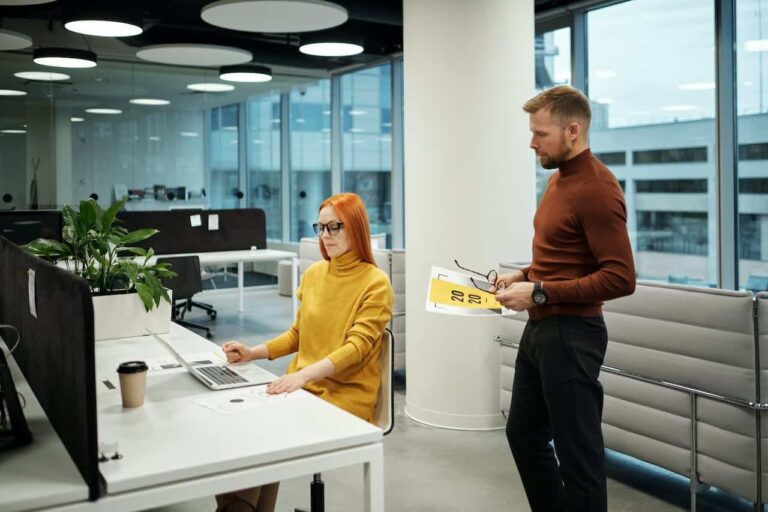BUSINESS & EDUCATION
Anticipating the Future: Office Design Trends for 2024

WORDS: Peter Minkoff PHOTOGRAPHY Supplied
The landscape of office design is transforming as we venture into 2024, propelled by sustainability, modernity, and the integration of smart technologies. This exploration delves into the dynamic trends shaping the workspaces of tomorrow, where a harmonious blend of environmental responsibility and cutting-edge innovations takes center stage.
The Rise of Smart Offices
Smart technologies are revolutionizing the modern office, making it more efficient and responsive to the needs of its occupants. Artificial intelligence (AI) powers smart lighting, climate control, and personalized workstations. Automation and data-driven insights are enhancing productivity and streamlining operations. In 2024, expect offices to be smart and intuitive, adapting to individual preferences and optimizing the work environment in real time.
Flexible Workspaces Evolved
The concept of flexible workspaces has matured beyond the traditional hot-desking model. The emphasis is on dynamic and adaptable environments that cater to the evolving nature of work. Modular furniture, movable partitions, and multifunctional areas enable employees to customize their surroundings, fostering collaboration or providing private retreats as needed. The office of the future is agile, recognizing that one size does not fit all in the realm of workspaces.
One of the things that stands out is a sit stand desk as an alternative to traditional workstations. The sit-stand desk, a dynamic and versatile alternative to conventional workstations, is taking center stage in the evolving narrative of office design trends for 2024. Recognizing the importance of movement throughout the workday, sit-stand desks allow employees to transition between sitting and standing positions seamlessly. This way, ergonomic concerns are addressed by reducing the risks associated with prolonged sitting and fostering a more active and engaged workforce. The sit-stand desk aligns with the ethos of adaptable workspaces, allowing individuals to tailor their environment to their preferences, enhancing comfort and productivity.
Sustainability at the Core
In 2024, the sustainability wave is not just a trend; it’s a fundamental ethos of a socially conscious business shaping office spaces. Designers are embracing eco-friendly materials, energy-efficient systems, and waste-reduction strategies to create workplaces with minimal environmental footprint. Green roofs, recycled furnishings, and energy-conscious designs are becoming staples as offices strive to be both aesthetically pleasing and environmentally responsible.
Biophilic Elements in Modern Offices
As the quest for sustainability continues, the integration of biophilic design elements is gaining prominence. Bringing the outdoors inside, what characterizes modern offices in 2024 are living walls, natural light optimization, and indoor greenery. They enhance the workspace’s visual appeal and promote employee well-being, connecting them with nature amidst the urban hustle.
Energy-Efficient Technologies
In the pursuit of sustainable practices, offices are increasingly incorporating energy-efficient technologies. Solar panels, innovative HVAC systems, and energy-monitoring solutions are integral to office design. Beyond reducing the environmental impact, these technologies contribute to cost savings, aligning sustainability with economic efficiency.
Employee Well-being as a Priority

Hybrid work option
Designers are steering towards environments that seamlessly accommodate both in-person and remote collaboration. The office of 2024 is not just a physical space; it’s a hub that supports the fluidity of hybrid work models. Flexible workspaces, modular designs, and integrated technologies foster an inclusive atmosphere where employees can seamlessly transition between remote and in-office work. This trend reflects the contemporary reality that the workplace is no longer confined to a singular location, emphasizing the importance of adaptability and connectivity in shaping the modern office landscape. As we embrace the era of hybrid work, the design ethos evolves to create spaces that bridge the physical and digital realms, facilitating collaboration regardless of the geographical location of the workforce.
Collaborative Spaces Redefined
Collaboration remains a cornerstone of modern work; in 2024, collaborative spaces are evolving. Technology facilitates seamless communication and collaboration, from virtual reality (VR) meeting rooms to interactive digital whiteboards. Designers are creating spaces that foster teamwork while accommodating the need for individual focus, striking a balance that aligns with the fluid nature of contemporary work.
In conclusion, the office design landscape in 2024 is a convergence of sustainability, smart technologies, and flexibility. It is a testament to the industry’s commitment to creating environments that are efficient and modern and responsible stewards of the planet. As we navigate this new era of workspaces, the focus is on a harmonious blend of innovation and sustainability, creating offices that meet the needs of today’s workforce and contribute to a better future for all.









